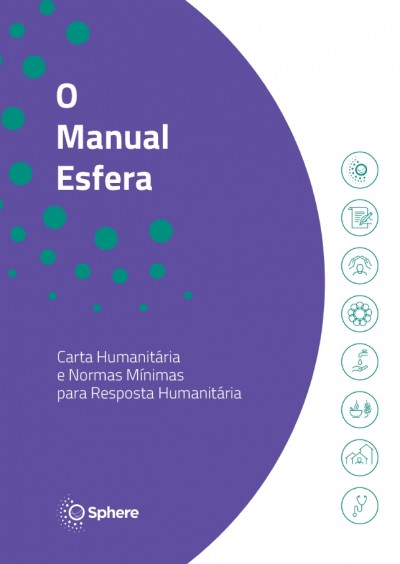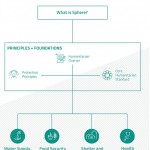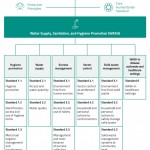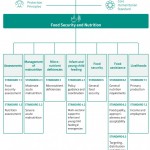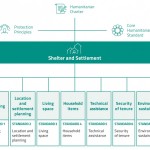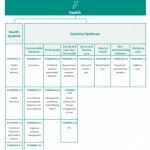On the International Day of the Book, we will speak about the newly published Sphere Handbook in Portuguese
Download the book in pdf Get the book
October 29 commemorates International Day of the Book. The homage paid to this unique instrument of human knowledge is justified: the book – which in spite of the proliferation of innovative technologies and means of support for the acquisition, dissemination and preservation of the word – still occupies today the place of honor in the history of humanity.
To celebrate this date, we bring the story of the process of putting together, from translation to publication, of the Sphere Handbook, an essential book and fundamental reference material in the response to humanitarian crises that befall humanity all around the planet – whether in environmental catastrophes, wars, ethnic conflicts, or social and economic crises.
This Handbook was translated for the first time into Portuguese through the dedicated work of the Irdin Editora team, in partnership with the Fraternity – International Humanitarian Federation (FIHF), the Sphere Focal Point in Brazil, and it will be available for purchase in physical format or may be downloaded in its digital format for free at the publisher’s website. You can also download it in English for free at the Sphere Standards website.
The importance of the translation of the Sphere Handbook
The book can play a decisive role in safeguarding and protecting the right to life, once the Handbook has been seen, the version in Portuguese of which is being launched by the Irdin Editora.
Originally published in English, this manual of guidelines for acting in humanitarian emergencies has editions in different languages. The Portuguese translation, promoted at the initiative of the Fraternity – International Humanitarian Federation (FIHF), in accordance with Sphere Standards, had been waited on mainly in countries on the African continent. It will have a significant impact on the humanitarian response to crises triggered by environmental, social and economic catastrophes or by conflicts, armed or not, anywhere on the planet where Portuguese-speaking missionaries and humanitarian agents are called to act.
Poverty, hunger, wars and natural or human-caused disasters leave millions of people around the world unable to survive in their places of origin, with physical, psychological and spiritual aftermaths that need attention and treatment.
The Sphere Handbook as one of the most accessed references for customizing humanitarian actions according to good practices that guarantee effectiveness and quality in the reconstruction of affected lives. Therefore, the new Portuguese version is a milestone for the improvement of ongoing missionary work, and for the training of new missionaries, making the guidelines, principles and values contained in the handbook accessible to all those involved in the humanitarian response, overcoming any eventual linguistic barriers that could limit its full use.
The translation into Portuguese, in addition to expanding the scope of this work to countries and cultures that adopt the Portuguese language, also inaugurates an important stage in the course of the Fraternity (FIHF) as the Sphere Focal Point in Brazil. This means that the FIHF is committed to promoting the use of the Handbook, and to becoming a point of convergence for individuals and organizations that wish to implement the Sphere guidelines in their activities of assistance in situations of catastrophes and disasters.
In this sense, the humanitarian response of the Brazilian government agencies will be encouraged to align with international protocols tested and approved by more than twenty years of specialist practices, in various areas of the provisioning of humanitarian aid, improving the technical quality of the initiatives to alleviate human suffering.
Unique experience – the story of a translator
The whole book elicits some kind of experience, and the involvement with the translation of the Sphere Handbook could not be different.
At first glance, the task seemed to me to be Herculean, not only because of the size of the work, the technicality of its content, but above all, because of the immense responsibility to guarantee a result equal to the translations standards established by the Sphere Movement.
I was fully convinced, however, that the feelings of joy and gratitude that permeated the entire team entrusted with the task were sufficient motivation to ensure a careful, meticulous, and precise work, as is the Sphere Handbook itself. In addition, here was an opportunity to contribute, albeit indirectly, in the planning programs to mitigate the vulnerability of people affected by humanitarian crises.
The challenges that appeared were overcome with patience, concentration and perseverance, in the aspiration of achieving the best possible result of what united intellect and heart were capable of.
During the seven months, the time taken had to be extended, family commitments were reduced to the minimum necessary and the task absorbed the physical and subtle energies. Processes and routines were done and redone so that each stage was completed within the schedules time. The translation of certain technical terms, which in the beginning seemed adequate, with the increasing disclosure of the content contained in the Handbook, often required adjustments to reflect the original text in a trustworthy manner. At other times, it was necessary to enlist the help of health and administration professionals to understand specialized concepts that escaped the translator. And up to the last moment, before it was sent out for publication, the text underwent detailed scrutiny to eliminate possible flaws.
The experience was not limited to translating terms, rules and norms of procedure. I conclude, with the agreement of all those who participated in this group offering – Irdin Editora coordinators, translators, proofreaders and designer – with the certainty that we share the same perception, that in each page we translated a deep collective feeling of gratitude, of unity and brotherhood, because of being able to collaborate and be a part of an institution dedicated to the exaltation and the dignifying of Life, selflessly disseminating peace.
The history of the book: from papyrus to e-book
The emergence of the book dates back to around 4,000 years ago, when the ancient Egyptians used palm leaves to document relevant facts. They developed papyrus from the stalk of the plant with the same name that, after proper processing, produced leaves, which were woven together in large rolls attached to a wooden stem, comprising a volume of up to 20 meters in length. It is said that in the library of Alexandria, founded in the third century BC, there were between 500 and 700 thousand rolls of papyrus with works representing all areas of thought from that time.
In the early centuries of the Christian era, parchment made of animal skin, and therefore more resistant, replaced papyrus. It was widely used in Western antiquity; the scrolls did not contain illustrations and the texts were done in columns, with no division between words. This was the material used until the 12th century, the monasteries being the major producers of parchments.
Not only did the support on which writing took place undergo significant changes, but also a major change occurred in the second century, giving rise to the book in the form which we are familiar with today. In place of the parchment roll, manuscripts made of folded, cut sheets of parchment, joined by stitching on one side and protected by a resistant cover were adopted. Originally, they were used by the Greeks to compile the laws and were consolidated in the Roman Empire when bookstores and the position of editor appeared. The change in shape in the volumes facilitated handling, transportation, storage in libraries, as well as the work of translators and copyists, once it made it possible to number the pages and compare the various examples of copies or translations of a same text.
The innovation was perfected and made widespread in the Middle Age by copyist monks, who enriched entire libraries with scrolls of classic texts from the Greco-Roman culture and Judeo-Christian tradition, illustrated with exquisite illuminations. The spread of the manuscripts was closely associated with the expansion of Christianity, so much so that the biblical manuscripts found since the second century are all in manuscripts.
Over time, margins, indexes, abstracts, and blank pages were added to the books, and the use of paper began, invented in China and brought to the West by the Arabs.
From the 12th century onward, the manuscripts left the religious environment and started circulating in the libraries and among the nobility, and the book became a symbol of prestige and intellectuality, becoming definitely popularized with the invention of printing with movable type by Gutemberg in 1445. The technique would inaugurate a revolutionary phase in the history of the book, making the cost less, streamlining production, favoring its diffusion and trade. The oldest printed book known is the Bible.
Currently, e-books are the going thing: a version presented in digital form, marketed and distributed over the internet to be read on the computer screen or on specific equipment. The advantages of such a format are highlighted by modern technology enthusiasts. However, the question remains whether a good and efficient paper book, made with raw materials generously donated by nature, to which bibliophiles devote unconditional faithfulness, will one day yield its nobility and enchantment to the seduction of the digital screen, or if both modalities will coexist, each offering its best characteristics. For the time being, the paper book continues to survive, attracting its loyal defenders to bookstores, who resist giving up the pleasure of inhaling the peculiar aroma of the virgin pages of a new book.
The importance of the book
From the brief foray into the origins and evolution of the book, one can extract the importance of this invention for the development of humankind. Depending on purpose attributed to it by the reader, the book can satisfy mere curiosity, fill idle hours with productive leisure, gather information on the most diverse subjects, or it can touch the soul, expanding the horizons of an existence, forming and transforming individuals and consciousnesses.
The book is a source of instruction, of building knowledge, of transmitting cultures and the very history of civilizations and peoples. It places us before different traditions and customs and makes it possible for experiences to be passed on from generation to generation, without the restrictions imposed by physical or linguistic boundaries. Through the book, we come into contact with the deeds of our ancestors, which otherwise might not be possible to access. We learn about our divine origin, about our links to the incomprehensible, and we connect with each other through the sharing of ideas.
The book has the property of linking past, present and future, and as if it were a great portal, defies time and space, placing us instantly in transcendental experiences. As an individual and solitary activity, which fosters introspection and inner silence, it allows us to search the most hidden places of our being, to explore mysterious and forgotten aspects in some fold of immemorial existences. It can play the role of a great healer, curing wounds, healing fears and lighting up shadows, in a cathartic and projective process. Regardless of the theme addressed, a good book always offers something to be learned, reflected upon, digested and assimilated. Something that will remain as part of our being, reverberating throughout our life and serving as a substrate for renewed learning.
A book is capable of prompting all of this. And even further. At the same time, it allows an inner plunge, the book opens our eyes to the surrounding scenery, to the difficulties of foreign, social, planetary and cosmic circumstances. It provokes the discovery of new universes, far beyond our own limitations, and stimulates the taste for exploring previously unknown environments. It confronts us with divergent opinions and encourages us to examine issues from other’s point of view, forging ever more solid levels of compassion. In a word: the book has the potential to make us more human, more loving and compassionate.
The book can encompass an entire universe and is configured into many categories and genres: there are books on narratives, stories, poetry, fiction, biographies, textbooks, spiritual books, scientific books, travel books, recipes, and self-help; encyclopedias, manuals, grammars. Books to look at life philosophically, to record history, to catalog words and educate children. There are books that are sacred, that connect with the Truth and sublime dimensions. Books can contain any area of knowledge, are destined for everyone and have the attribute of being more or less complex, according to the reader’s ability to go deeper and adapt the studying to the limits of their own understanding.

